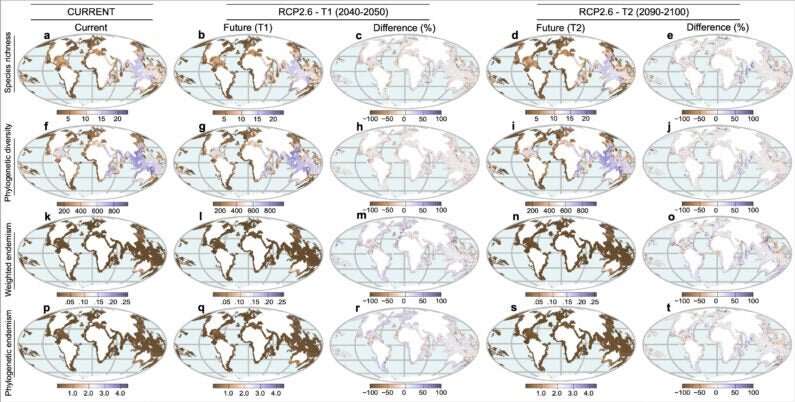Exploring the Effects of Climate Change on Seagrass Meadows

June 21, 2023
This article has been reviewed and edited according to Science X's editorial process and policies, ensuring its credibility. The editors have fact-checked, peer-reviewed, and proofread the content, relying on a trusted source. The author, Holly Alyssa MacCormick, hails from Stanford University.
Seagrasses play an essential role in the marine food chain, yet their importance often goes unnoticed. These underwater meadows produce oxygen, remove carbon dioxide from the air, and provide food and shelter for marine life. However, a recent Stanford study has warned that seagrasses may be in peril. According to the study, which modeled the distribution of seagrass species around the world at two different timepoints in the future, climate change could jeopardize seagrass populations.
Marine species are highly susceptible to the effects of climate change, as oceans absorb an estimated 80 percent of the excess heat from greenhouse gas emissions. However, it is unclear how seagrasses will fare in the future or whether marine protected areas can save them.
Barnabas Daru, assistant professor of biology in the Stanford School of Humanities and Sciences, explained, “The simple question we ask in this paper is, 'How will seagrasses—which are a foundational group in the marine food chain—respond to climate change?”
Seagrasses are ancient plants that originated in the ocean, migrated to land, and returned to the sea around 140 million years ago. They serve as grazing grounds for herbivores such as green sea turtles, manatees, and parrotfish. Seagrass meadows also function as nurseries for commercial fisheries, with roughly 20 percent of the world's large commercial fisheries relying on them.
However, many marine organisms indirectly benefit from seagrasses as well. Sharks, for instance, feed on marine animals that may consume plants. If seagrasses, which are at the beginning of the food chain, are affected, it could have cascading impacts on other organisms high up in the food chain, including humans. Seagrasses reach across approximately 116,000 square miles of coastline bordering 191 countries on all continents except for Antarctica, making them challenging to model to predict the effects of climate change.
To conduct their research, Daru and researcher Brianna M. Rock from the Clearwater Marine Aquarium Research Institute in Florida mapped the location and abundance of each seagrass species using 100 years of collected seagrass samples from coastal ecosystems. They combined these data with information from public databases of seagrass occurrence, such as the Global Biodiversity Information Facility and Seagrass-Watch. They used geophysical and environmental data from the Bio-ORACLE website to create global snapshots of the ocean's climate for the contemporary era and two future periods: 2040-2050 and 2090-2100.
Daru modeled four different scenarios for the present and two future periods. They included a best-case climate with low greenhouse gas concentrations, two stabilized scenarios where greenhouse gas levels plateaued, and a worst-case scenario with high concentrations. All four modeled scenarios included data on sea temperature, salinity, and sea current speed, which profoundly affects seagrass growth distribution and photosynthesis. Finally, Daru applied a computer model of the observed species occurrences to each climate scenario to predict how seagrass populations and distributions might change between the present and two future periods.
The study discovered that seagrasses would experience widespread reductions in species diversity. A significant proportion of seagrasses are likely to suffer in hotspots outside the current marine protected areas network. Even the best-case scenario predicted that seagrasses' abundance and composition would decline under all modeled simulations. The study's results highlight the need for immediate action to save seagrasses, one of the unsung heroes of the ocean.
'It probably means that 'the best' is still not enough,' Daru said. 'We have to be more intentional in how conservation efforts are prioritized and this sort of analysis points to the places where these efforts should be done.'
Importantly, the findings of this study also indicate that the current network of marine protected areas is not sufficient.
'One of the signatures of this modern era of profound human impact on the environment is not even the loss of species, but the reorganization of biotic communities. The homogenization of communities is likely to lead to a more profound impact on biodiversity than even the loss of species,' Daru said.
When ecosystems become homogenized they lose their distinctiveness and uniqueness, and the decrease in diversity makes them more susceptible to disease and extreme weather events. Such a change could impact both the ecosystem services provided by these communities and the marine life that depends on them. It also may force marine animals that specialize on certain seagrasses to relocate or adapt to less favored seagrass species if their preferred seagrass is lost, which can reduce their fitness and survival.
Despite these sobering findings, the future of seagrasses is far from hopeless.
'We highlighted hotspots of change in species diversity and phylogenetic diversity that represent priority regions to target for conservation efforts,' Daru said. 'Our goal, our hope is that by pointing policymakers and conservationists to focus on these hotspots, marine protection will be increased in these areas and the future of seagrasses will—to some extent—be safeguarded.'
Journal information: Nature Plants
Provided by Stanford University




